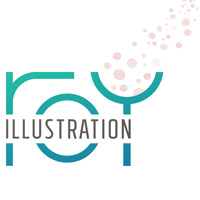QUESTIONS AND ANSWERS
There are certain questions we hear more than others. This is our place to try to provide thorough answers to your questions.
By the way, this is an ongoing list! Please ask YOUR question.
Questions and Answers about
WORKING WITH US
What can we expect from the illustration process?
We’ve developed a multi-stage process for our work. We start by working with you to identify the unique challenges associated with your project. Most projects then go through 2-4 drafts. You will have the chance to give feedback after each draft. Working this way keeps everyone on the same page, and it leads to project success!
Check out Our Design Process for more info on how we work and a sample project workflow.
What is your background?
Our team have backgrounds in science and fine art. Our founder, Laura Roy, is a Board-Certified Medical Illustrator who attended Johns Hopkins School of Medicine. Jeremy’s background is as a fine artist and designer. Both Jeremy and Laura also attended culinary school!
Read more about our stats and backgrounds.
Can we work remotely?
Yes! We live in an age where it is easy to work remotely. In many ways, working remotely is even more convenient because no one has to commute to a meeting.
We are happy to communicate over email, phone, or video conference–whatever works best for you. We can easily share drafts and final files using Dropbox or your preferred service.
Still have any questions? Get in touch.
What is the process for large projects?
We enjoy working on large projects, because it allows us to really dive into your topic. The process can be variable based on your needs, but we’re happy to work with you to identify them. If you’re not sure what your project should consist of, we offer consulting services to help.
As an example, for a textbook we would estimate the number of figures as well as their complexity. Based on the number of simple, medium, high complexity, or other unique figures, a total estimate will be calculated.
For every project–large and small–we will create an estimated production timeline that will guide draft development.
Check out our design process for a sample project workflow.
Questions and Answers about
MEDICAL ILLUSTRATION
How did you get into medical illustration?
“I was always interested in both science and art. When I started my undergrad studies, I was double-majoring in Biochemistry and Studio Art, and I planned I’d become a physician who also created art. Neither of these felt quite right though, so instead I studied Philosophy.
“Then, I spent years traveling and exploring careers that included both arts and science. I went to culinary school, became a Certified Sommelier, and worked making wine in both hemispheres of the globe.
“Somewhere along the way, I learned about the field of medical illustration, and the idea stuck. I finished my pre-med requirements and was thrilled to be accepted to Johns Hopkins University School of Medicine‘s Art as Applied to Medicine program.
“After that, it’s all wonderful, fulfilling, and exciting history.” -Laura
Read more about us here.
What does the training consist of?
Most medical illustrators have a master’s degree from an accredited grad school. There are currently four programs in North America. All accredited medical illustration schools have the same basic program requirements, but each is unique in what it offers as well.
Get thorough answers to many related questions at the Association of Medical Illustrator’s website.
Read about the Johns Hopkins Art as Applied to Medicine program (Laura’s alma mater).
Where should I study for undergrad?
There are many options, but you will primarily want to make sure you are fulfilling the requirements for grad school. Check out the requirements for each grad program to ensure you meet the requirements in undergrad.
Laura attended and now teaches at Iowa State University‘s Biological/Pre-Medical Illustration Program. It is an excellent, rigorous program that prepares students well. However, it is just one of many great options.
Where should I go to grad school?
You can’t go wrong with any of the accredited medical illustration grad schools. They all do an excellent job! I suggest looking into each to see which seems right for you. Visit if possible, look at their curriculum, talk to current students as well as graduates, and check out student portfolios.
Get thorough answers to many related questions at the Association of Medical Illustrator’s website.
Questions and Answers about
ART, ILLUSTRATION, AND TECHNIQUE
How did you do (X), (Y), or (Z)?
We recently started our blog to capture our thought processes, share ideas, and to demonstrate techniques.
If you have a specific interest or request, let us know on our roysources contact form.
Do you have any recommendations for books?
Yes, we have put together a running list of our favorite books. You can check it out here. Have anything you think we’re missing out on? Let us know!
What do you use for watercolor?
Laura’s whole list of preferred watercolor paints, palette, brushes, and papers are in our top tools list. Don’t see what you were looking for? Let us know!
What materials, software, hardware, etc. do you use for your art and illustration work?
We have a running list of top tools where we note our favorite and most used materials, supplies, etc. Don’t see what you were looking for? Let us know!

